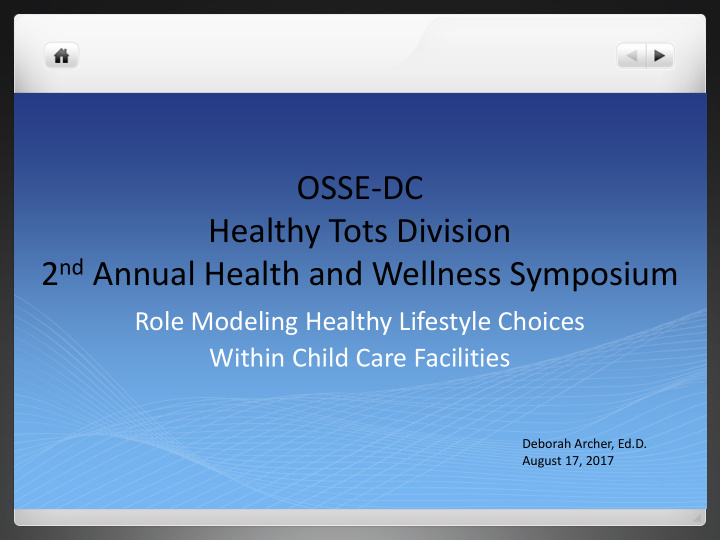



OSSE-DC Healthy Tots Division 2 nd Annual Health and Wellness Symposium Role Modeling Healthy Lifestyle Choices Within Child Care Facilities Deborah Archer, Ed.D. August 17, 2017
Role Modeling Healthy Lifestyle Choices To: Improve self-efficacy around nutrition principals Provide recommendations to improve staff wellness Identify ways to create a staff wellness policy
Benefits of Creating Healthier Child Care Environments Medical costs associated with obesity is estimated to be approximately $147 billion and expected to increase to $210 billion by 2020. According to the Centers for Disease Control, two out of three adults are overweight or obese.
Impact of Role Modeling on Child Health Evidence-based research verifies that healthy, active children learn better. More than one in three children is at risk for developing diabetes, heart disease, and cancer later in life. Since children spend many of their waking hours and eat up to half their daily calories at school, schools play a critical role in cultivating healthy nutrition and physical activity habits.
Why Should You Be a Role Model? Although children make up 25 percent of the US population, the share of federal spending dedicated to children is just 8 percent of the federal budget https://www.youtube.com/watch?v=IkoC3HZwe7Q First Focus Advocacy Organization
Determining Needs Conduct a workplace wellness assessment •Analyze program evaluations •Distribute an employee interest survey •Offer a health risk assessment (HRA) and/or health screening •Analyze data (medical, pharmacy, demographics)
Developing a Wellness Team Formally appoint team members and a leader • Promote the wellness team within the organization • Include employees from all levels and areas of the child care organization • If multi-location, name a Wellness Champion per worksite • Meet on a regular schedule with a formal agenda • Communication is the key Bev Losey, CLU •
What is a Policy? A policy is a written course of action that is enforced. Policies are established to guide and determine present and future decisions.
Creating a Staff Wellness Policy Obtain support/Gain Buy-In Create a mission statement/ brand your child care program Create a long-term strategic plan. Consult with other child care centers (comparable in size) to learn about successful and unsuccessful implementation strategies
Key Components of a Wellness Policy Nutrition Health Education - Competitive Foods Community and Family Engagement -Nutrition Promotion Staff Wellness and -Nutrition Education Health Promotion -Food and Beverage Marketing • Physical Activity/PE
Developing An Action Plan Address individual, environmental, policy and cultural factors affecting health and productivity Target several health areas simultaneously Tailoring programs to address specific needs of the population Generate interest to attain high participation rates Evaluate outcomes Effectively communicating those outcomes to key stakeholders AnnuRev Public Health. 2008;29:303-23. The health and cost benefits of work site health-promotion programs. GoetzelRZ, OzminkowskiRJ. Department of Health and Productivity Research, Thomson Healthcare, Washington, DC 20008, USA. Ron.Goetzel@Thomson.com
Role Modeling Healthy Behaviors Walking Programs Yoga-Stress Management Biking to Work Healthy Recipe Swaps Healthy Cooking Competitions
Make Half Your Plate Fruits and Vegetables?
Healthy Food and Beverage Options Do Not Skip Meals- Plan Your Meals and Family Style Snacks Choose a Variety of Water-Preferred Colors-Vitamins and Beverage-Water Bottle Minerals on Desk Limit Your Intake of Limit Caffeine-2:00 pm Sugars Rule* PAndrea Hart, RD, CDN
Benefits of Staff Wellness Programs 2.2 Million People Work in Child Care and Education Settings Health and Wellness is Often Overlooked Child Care Staff are Role Models and Can Provide Knowledge and Healthy Behaviors -National Head Start Association
Benefits of Staff Wellness Programs Reduces the Rate of Increases Productivity Employee Improves Morale Absenteeism Lowers Workers Lowers Health Care Compensation Costs National Head Start Association
Action Plan Tips for Sustainability Contact Insurance Apply for Small Companies and Broker Wellness Grants Available Services Annual Health Contact Local Fairs/Screenings- Department of Parks Department of Health and Recreation to and Other Community Request Resources Resources
Let’s Move, Jump, and Play!
Best Practices When Developing a Staff Wellness Policy Get senior level support. Successful wellness programs start at the top. Remember, creating a culture of health takes passionate leadership from all levels of the organization. Use data to drive wellness initiatives. Employers often struggle with what wellness initiatives have to offer. A survey, assessment checklist, and health risk appraisal approach guides employers where to focus your efforts. No program is successful without a plan. Develop an annual workplace wellness operating plan, starting with a vision statement. www.shrm.org/templatestools/howtoguides/howtoestablishandesignawellnessprogra m
FINAL THOUGHTS… Choose appropriate health initiatives. Collecting data will help you decide 1. what wellness initiatives to promote. Note a variety of lower cost resources and activities exist. Create a corporate environment that supports wellness. Support a culture 2. of health, from top to bottom and bottom to top. Evaluate the outcome of workplace wellness initiatives. Determine what 3. works and what doesn’t so you can plan for the next year.
Thank You
Recommend
More recommend